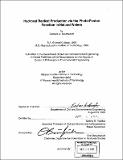Hydroxyl radical production via the photo-Fenton reaction in natural waters
Author(s)
Southworth, Barbara A. (Barbara Anne), 1973-
DownloadFull printable version (5.262Mb)
Other Contributors
Massachusetts Institute of Technology. Dept. of Civil and Environmental Engineering.
Advisor
Bettina M. Voelker.
Terms of use
Metadata
Show full item recordAbstract
This dissertation investigates the importance of photo-Fenton chemistry in natural waters. The Fenton reaction, H202 + Fe(ll) [right arrow] Fe(ll) + OH- + OH', can occur in sunlit waters because both H202 and Fe(ll) are photo-chemically produced. Photo-Fenton chemistry was investigated by irradiating model systems and natural water samples with simulated sunlight and measuring both H202 accumulation and OH' production in the presence and the absence of Fe reactions. Using these data, a model was developed to calculate the potential impact of the photo-Fenton reaction in sunlit natural waters. Throughout this work, a method based on the chemiluminescent reaction of an acridinium ester compound with the conjugate base of H202 was used to analyze H202. This method is sensitive, and has a greater dynamic range, greater selectivity, and fewer sources of interference than more commonly used methods. However, its behavior is not consistent with a simple reaction mechanism. The kinetics of the chemiluminescent reaction were investigated and a mechanism proposed that can explain its behavior, confirming the ability of this method to accurately measure H202, and suggesting ways to avoid potential problems with its application. The photo-Fenton reaction was studied in model systems consisting of a standard humic substance and amorphous iron oxide exposed to simulated sunlight. A probe method was adapted to allow low concentrations of OH' to be measured without otherwise influencing the chemical reactions occurring in experiments. The difference between measured H202 accumulation in the presence and absence of Fe in these systems was interpreted as the photo-loss of H202 by reaction with Fe(ll). (cont.) Both this photo-loss, as well as measured losses of H202 by reaction with Fe(ll) in the dark, produced the expected quantities of OH'. The photo-loss of H202, as well as the production of OH' due to Fe, were eliminated by the addition of the iron ligand, desferrioxamine mesylate (DFOM). If Fe is also the major sink of H202 in natural waters, sufficient H202 is produced to be an important sink of organic compounds in relatively shallow fresh waters. The amount of H202 that will react to form OH' in natural waters is dependent on the ability of Fe(ll) to outcompete other sinks of H202. Light attenuation and mixing processes will dilute both H202 and Fe(ll) in natural waters, slowing the reaction rate with each other and decreasing the yield of OH' from H202. To investigate these effects, a model was developed using experimental data for the accumulation of H202 in model systems exposed to different intensities of light and rate constants measured in the dark. Assuming that the same processes occur in natural waters, the effects of light attenuation and mixing were calculated as a function of depth and organic matter concentration. Sufficient Fe(ll) will be produced at pH 6 to result in half-lives of organic compounds due to photo-Fenton chemistry on the order of weeks to months at depths less than 10 meters. The methods used to study photo-Fenton chemistry in model systems were applied to two natural water samples from freshwater systems in which photo-Fenton chemistry is likely to occur ...
Description
Thesis (Ph. D.)--Massachusetts Institute of Technology, Dept. of Civil and Environmental Engineering, 2002. Includes bibliographical references.
Date issued
2002Department
Massachusetts Institute of Technology. Department of Civil and Environmental EngineeringPublisher
Massachusetts Institute of Technology
Keywords
Civil and Environmental Engineering.